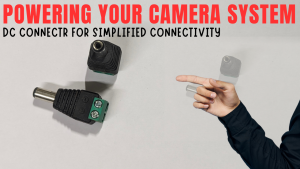Objective-
[How to connect a CCTV Camera to DVR] Objective of this article is to understand types of cable used in CCTV systems and how to connect cameras to DVR using these cables. We will be discussing the differences between using these cables. Connections techniques. In this document we will be discussing the types of cables used, different connector configurations associated with 3+1 and CAT6 setup.
Part 1- How to connect CCTV camera to DVR Digital Video Recorder using CAT6 cable and video baluns:
This setup uses CAT6 cable to carry video output generated by CCTV Camera. Cat6 has major benefits when it comes to transfer power over long distance (Usually greater than 90Mtr). CAT6 is less likely affected by electromagnetic interference, has solid copper core twisted to provide lossless video transfer.

List of Equipment’s Required-
In order to demonstrate the connection we need following items in-place.
- CCTV Camera
- DVR- Digital Video Recorder
- CAT6 Cable (Dlink, Honeywell, CPPLUS)
- Video Baluns (2 Per Camera)
- Power Supply for Camera
- Connectors (DC Pin)
Step 1- Connect the camera to the balun-
Video Balun comes with two ends, one end is BNC Female and other end has two push in terminals for CAT6 pair. Connect BNC connector end of video balun to the BNC video output of CCTV camera as shown in below image. Short video is shared for better understanding.
Step 2- Connect CAT6 Cable to Video Balun
Video Balun that we have used has two terminal connection provision. As you can see there are two push in terminals in which cable wire to be inserted.
Camera End- Take one end of CAT6 cable choose a pair through which video signal is to be transmitted, once finalized insert the pair of cable into the push in terminal of first Video Balun.
DVR End- Take other end of the CAT6 cable, choose the pair of cable that is connected at Camera end, use same pair of cable and insert in push-in terminal of second Video Balun.
Cross connection is not allowed, cross-connection may result in “No Video Signal” issue. Best way to avoid cross-connection is firstly decide the color code and connect as per polarity.
Step 3- Connect Video Balun to the DVR
Similar to camera end balun, connect/insert the BNC male connector of DVR end balun into DVR channel of your wish.
Step 4- Power On the system
Use same CAT6 Cable to provide/carry power to Camera from power supply, choosing all remaining pairs to carry DC power is highly recommended. With power in place, power on the DVR and navigate to the appropriate channel on screen, to see output of camera to check its quality and perform viewing angle settings.
Always keep in mind-
Use high-quality CAT6 cable and video baluns for best results. Make sure all connections are secure. Refer the manuals for your specific camera and DVR for detailed instructions.
Part 2- How to connect CCTV camera to DVR Digital Video Recorder using Coaxial cable (3+1)
[How to connect CCTV Camera to DVR] It is a budget friendly option many system integrator recommends. This cable is made up of solid bare copper and comes in a 90-meter length. It’s ideal for surveillance use, has an easy application process.
This CCTV cable has 4 separate cores, mainly divided into two parts. One is Solid copper(Video core) that is used for Video, and another is Multi strand copper(Power cores) those are used for Power. Anatomy of Co-axial Cable shown in below image.

Tools and materials:
- CCTV cable 3+1
- BNC connectors
- Cable stripper
- Crimping tool or Plier
- DC PIN
Instructions:
- Cut the CCTV cable to the desired length.
- Strip the outer jacket of the cable to expose the inner wires.
- Slide the BNC connector over the inner wires.
- Crimp the BNC connector to the cable using a crimping tool.
- Repeat steps 3 and 4 for the other end of the cable.
On the go tips- How to connect CCTV Camera to DVR?
Handy tips for [How to connect CCTV Camera to DVR]-
Use a cable tester to verify the connections. Label your cables for easy identification. Consider using a patch panel for a more organized setup. If you are running the cable outdoors, use weatherproof connectors and enclosures. Make sure that the BNC connector is compatible with the CCTV cable. Use a sharp cable stripper to avoid damaging the inner wires. Crimp the BNC connector tightly to ensure a good connection.




